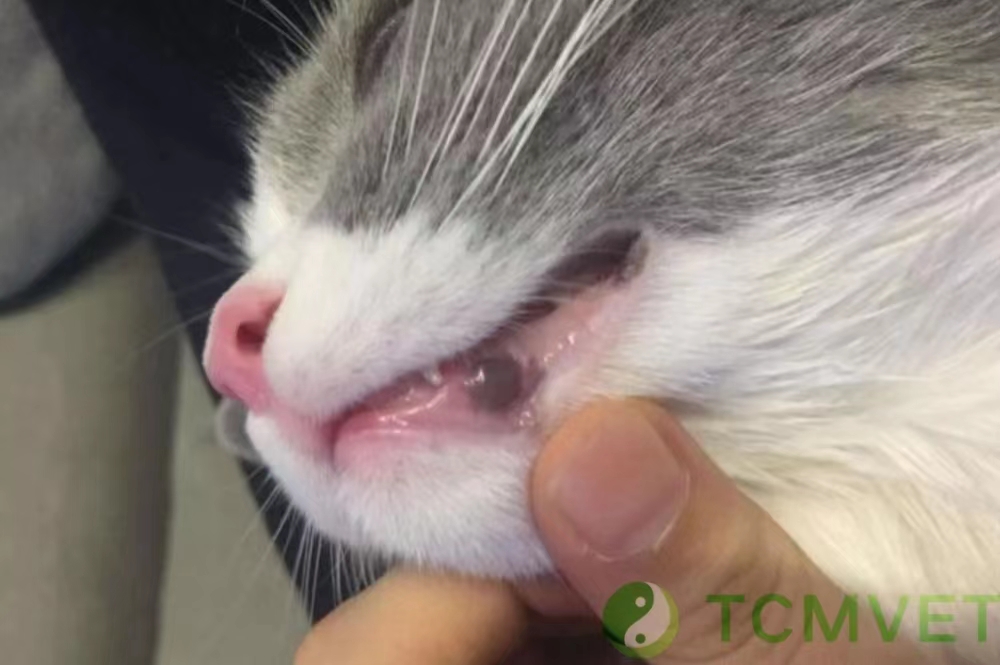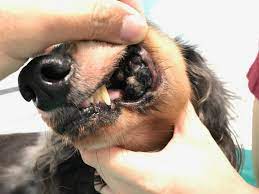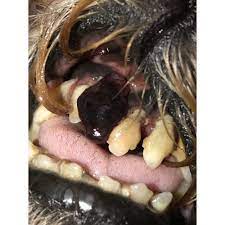
by TCMVET | Mar 6, 2024 | Dog Cancer & Tumors
Melanoma, a form of cancer arising from pigment-producing melanocytes, is a significant health concern in dogs and, to a lesser extent, in cats. This comprehensive guide aims to shed light on the characteristics, diagnosis, and potential treatment options for melanoma in these animals, providing valuable information for pet owners and veterinary professionals alike.
What is Melanoma?
Melanoma is a cancer that originates in melanocytes, the cells responsible for pigment production in the skin and other parts of the body. In dogs, it is a relatively common cancer, especially in breeds with considerable skin pigmentation. Unlike in dogs, melanoma is rarer in cats but tends to be more malignant when it occurs.
Common Sites and Appearances
In dogs, melanomas are most frequently found on the haired skin, presenting as small, brown to black masses. They can also appear as larger, flat, and wrinkled masses. Primary melanomas in dogs may also develop in the oral cavity, nailbed, footpad, eye, gastrointestinal tract, nasal cavity, anal sac, or mucocutaneous junctions. The most common site for oral melanoma in dogs includes the gingiva, lips, tongue, and hard palate.
Risk Factors and Causes
Unlike human melanomas, which are often linked to UV light exposure, canine melanoma is less likely attributed to sunlight due to the protective hair coat of most breeds. However, the exact risk factors for canine melanoma are not well established. In cats, melanoma is less common and its causes are similarly complex and not fully understood.
Diagnosis and Pathology
Diagnosing melanoma can be challenging, especially anaplastic amelanotic melanomas that resemble soft tissue sarcomas. Immunohistochemical methods are frequently used to increase diagnostic precision, employing antibodies like PNL2 and tyrosinase, in addition to Melan A and S-100.
Molecular Biology Insights
Canine and feline melanomas have a limited molecular characterization compared to human melanomas. In canine oral malignant melanomas (MMs), BRAF mutations common in human cutaneous melanoma are uncommon. However, ERK activation similarities in human and canine MMs suggest potential parallels in molecular pathways. Researchers have also identified other molecular abnormalities in canine and feline melanoma, providing new avenues for treatment research.
Treatment Options and Research
The treatment of melanoma in dogs and cats depends on various factors, including the location, size, stage, and histological characteristics of the tumor. Some of the treatment options include:
- Surgery: The primary treatment for localized melanoma, aiming to remove the entire tumor.
- Radiation Therapy: Often used for tumors that cannot be completely removed surgically.
- Chemotherapy: Employed in cases where the melanoma has spread, although its effectiveness can vary.
- Immunotherapy: A newer approach, such as the use of Oncept vaccine in dogs, specifically designed for canine melanoma.
Future Therapeutic Targets
Recent transcriptome analysis in canine melanoma has revealed new therapeutic targets in the focal adhesion and PI3K-Akt signaling pathways. Furthermore, the presence of exon 11 c-kit gene mutations in some dogs with malignant melanoma opens up the possibility for targeted therapy using KIT small molecule inhibitors.
The Road Ahead
Continued research into the molecular biology of canine and feline melanomas holds promise for the development of more effective treatments. Understanding somatic mutations in genes like NRAS and PTEN, similar to human melanoma hotspots, may offer new therapeutic avenues.
Melanoma in dogs and cats presents a unique set of challenges in veterinary medicine. Ongoing research and advances in molecular biology are key to improving diagnosis and treatment. Pet owners should be aware of the signs and consult with a veterinarian for early detection and optimal care.

by TCMVET | Mar 5, 2024 | Dog Cancer & Tumors
Oral tumors in dogs account for about 6% of all canine tumors and are a significant concern for pet owners and veterinarians. This article provides an in-depth look at the various types of oral tumors in dogs, their prevalence, symptoms, and effective treatment options.
Types of Canine Oral Tumors: Oral tumors in dogs can be classified into several categories based on their histological makeup, including:
- Epithelial Tumors: Such as squamous cell carcinoma (SCC), papillomas, fibropapillomas, intraosseous carcinomas, and infiltrative nasal carcinomas.
- Melanocytic Tumors: Including malignant melanomas.
- Mesenchymal Tumors: Like fibrosarcomas, hemangiosarcomas, and osteosarcomas.
- Mixed Tumors: Such as transmissible venereal tumors and lymphomas.
- Odontogenic Tumors: Specific to tooth-forming tissues, including ameloblastomas.
Epidemiology and Prevalence: Oral tumors are more common in older dogs and certain breeds, such as Cocker Spaniels and German Shepherds. Symptoms such as decreased appetite, bad breath, tooth loosening or loss, bleeding, eye protrusion, nosebleeds, swallowing difficulties, chewing pain, and increased thirst are often observed.
Diagnosis and Treatment: Early diagnosis through biopsies is essential for effective treatment, which may include surgery, radiation, or chemotherapy, depending on the tumor type.
Understanding the types, symptoms, and treatment options for canine oral tumors is crucial for early detection and effective management. Regular veterinary check-ups are vital for maintaining the oral health of dogs and catching any anomalies early.

by TCMVET | Mar 5, 2024 | Dog Cancer & Tumors
Malignant melanoma stands out as the most prevalent oral tumor in dogs, accounting for 30%-40% of all malignant oral tumors. This article aims to provide a detailed overview of malignant melanomas in canines, focusing on their prevalence, risk factors, symptoms, and treatment options.
Prevalence and Risk Factors: Malignant melanoma typically affects older dogs, with an average onset age of around 12 years. It is more common in male dogs and is seen with a higher frequency in dogs with darker oral mucosa. Certain breeds, such as Chow Chows and Golden Retrievers, are at a higher risk of developing this condition.
Symptoms and Diagnosis: Malignant melanomas in dogs can occur in various locations within the mouth, including the gums, cheek mucosa, lips, hard and soft palates, and the tongue. These tumors are often firm and darkly pigmented, although about 33% of cases may present as non-pigmented tumors. They can sometimes have ulcerated or necrotic surfaces. Rapid growth and local infiltration are characteristic of these tumors.
Treatment and Management: The management of malignant melanoma in dogs requires an integrated approach involving surgical removal, possibly followed by radiation therapy or chemotherapy. The prognosis depends on the stage of the tumor at diagnosis and the effectiveness of the treatment.
Early detection and prompt treatment are key in managing malignant melanoma in dogs. Regular veterinary check-ups and awareness of the symptoms can help in early diagnosis, improving the chances of successful treatment.

by TCMVET | Mar 5, 2024 | Dog Cancer & Tumors
Canine oral tumors are a significant health concern for dog owners and veterinarians. They account for about 6% of all tumors in dogs and can occur in various oral locations including the lips, cheek mucosa, upper and lower jaws, palate, teeth, tongue, and tonsils. This comprehensive guide aims to shed light on the different types of oral tumors in dogs, their symptoms, diagnosis, and treatment options.
Types of Canine Oral Tumors: Oral tumors in dogs can be classified into several types based on their tissue origin. These include:
- Epithelial Tumors: The most common type is the squamous cell carcinoma (SCC), but this category also includes papillomas, fibropapillomas, intraosseous carcinomas, and infiltrative nasal carcinomas.
- Melanocytic Tumors: Malignant melanomas are a serious concern due to their aggressive nature.
- Mesenchymal Tumors: These include fibrosarcomas, hemangiosarcomas, granular cell tumors, mixed mesenchymal sarcomas, neurofibrosarcomas, undifferentiated sarcomas, myxosarcomas, chondrosarcomas, osteosarcomas, and multilobular osteochondrosarcomas.
- Odontogenic Tumors: These originate from tooth-forming tissues and include ameloblastomas, calcifying epithelial odontogenic tumors, and odontomas.
- Miscellaneous Tumors: This group includes transmissible venereal tumors, mast cell tumors, lymphomas, and plasma cell tumors.
Symptoms of Oral Tumors in Dogs: The clinical signs of oral tumors in dogs can vary, but common symptoms include:
- Decreased appetite
- Bad breath
- Loose or missing teeth
- Blood in saliva
- Bulging eyes
- Nasal discharge or bleeding
- 吞咽困难
- Chewing difficulty or pain
- Excessive drooling
Diagnosis of Canine Oral Tumors: Early diagnosis is crucial for effective treatment. Diagnostic methods include:
- Physical examination
- Biopsy and histopathology
- Radiography (X-rays)
- CT scans or MRI for advanced imaging
Treatment Options: The treatment of oral tumors in dogs depends on the type, location, and stage of the tumor. Common treatment methods include:
- Surgery: This is often the primary treatment for removing the tumor.
- Radiation Therapy: Used primarily for tumors that cannot be completely removed surgically or for palliative care.
- Chemotherapy: Often used in conjunction with surgery or radiation.
- Immunotherapy: Emerging as a potential treatment, especially for melanomas.
Prevention and Prognosis: While there is no sure way to prevent oral tumors in dogs, regular dental care and check-ups can help in early detection. The prognosis depends on the type of tumor, with some like SCC and melanomas having a more guarded prognosis due to their aggressive nature.
Oral tumors in dogs are a complex health issue that requires prompt attention and specialized care. Understanding the types, symptoms, diagnosis, and treatment options is crucial for dog owners and veterinarians. Early detection and appropriate treatment can significantly improve the quality of life and prognosis for dogs with oral tumors.

by TCMVET | Mar 2, 2024 | Dog Cancer & Tumors
“Nature’s Healing: Traditional Chinese Herbs as a Complementary Therapy for Canine Cancer” delves into the realm where ancient practices meet modern veterinary science. This comprehensive article explores how traditional Chinese herbs are being used as complementary treatments in canine cancer, offering a holistic approach to pet healthcare.
Understanding Canine Cancer
Canine cancer, a leading cause of death in dogs, presents in various forms like lymphoma, mast cell tumors, and osteosarcoma. While modern medicine has advanced in treating these cancers, the search for less invasive and more holistic approaches remains paramount.
The Role of Traditional Chinese Medicine (TCM)
TCM, a millennia-old medical practice, uses natural herbs and holistic techniques to treat illnesses. Unlike Western medicine, which often focuses on directly combating diseases, TCM aims to restore the body’s balance and strengthen its natural defense mechanisms.
TCM Herbs in Canine Cancer Treatment
The use of TCM herbs in canine cancer treatment is based on the concept of addressing the underlying imbalances leading to the disease. The article will detail commonly used herbs like:
- Huang Qi (Astragalus): Known to boost the immune system.
- Yunnan Baiyao: Traditionally used to control bleeding and enhance wound healing.
- Dang Gui (Angelica Sinensis): Improves circulation and works as an anti-inflammatory agent.
Integration with Conventional Cancer Therapies
A key focus of the article is the integration of TCM herbs with conventional cancer treatments such as chemotherapy and radiation. This integrative approach can potentially minimize side effects, improve the quality of life, and enhance the overall efficacy of treatment.
Scientific Backing and Veterinary Perspectives
The article examines the scientific research supporting the use of TCM in treating canine cancer, alongside insights from veterinary oncologists who have adopted this approach. It discusses clinical trials and studies that validate the effectiveness of specific herbs.
Case Studies and Success Stories
Real-life case studies and success stories from pet owners and veterinarians will be featured, providing a personal and practical perspective on the use of TCM in canine cancer treatment.
A Guide for Pet Owners
Practical advice for pet owners considering TCM herbs for their dogs will be included. The article emphasizes the importance of consulting with a veterinary professional experienced in both TCM and conventional oncology.
“Nature’s Healing: Traditional Chinese Herbs as a Complementary Therapy for Canine Cancer” aims to enlighten pet owners about the benefits of integrating traditional herbal remedies with modern cancer treatments, offering a more compassionate approach to managing canine cancer.

by TCMVET | Mar 2, 2024 | Dog Cancer & Tumors
The article “Paws and Plants: Exploring Herbal Remedies for Canine Cancer” delves into the increasingly recognized role of herbal medicine in the treatment of cancer in dogs. As pet owners seek gentler, yet effective alternatives to conventional treatments, the world of natural remedies offers promising possibilities.
The Prevalence of Cancer in Dogs
Cancer is a leading cause of death in dogs, particularly in older pets. The disease’s complexity and the variety of forms it takes – from lymphomas to skin cancers – pose significant challenges in treatment.
The Rise of Herbal Medicine in Veterinary Care
Herbal medicine has been gaining traction in the veterinary field as a complementary approach to traditional cancer therapies. This shift is driven by the desire to minimize side effects and improve the quality of life for canine patients during treatment.
Understanding Herbal Remedies
Herbal remedies involve the use of plants and plant extracts to promote health and treat illness. Unlike pharmaceuticals, these remedies work in harmony with the body’s natural processes. They are known for their holistic approach, treating the whole organism rather than just the symptoms of a disease.
Key Herbs Used in Canine Cancer Treatment
- Turmeric (Curcumin): Renowned for its anti-inflammatory and anti-cancer properties.
- Milk Thistle: Supports liver health, crucial when dogs undergo chemotherapy.
- Astragalus: Known to boost the immune system, enhancing the body’s natural defense against cancer cells.
- Hemp Oil/CBD: Gaining popularity for its pain relief and anti-cancer effects.
The Science Behind Herbal Treatments
The article will explore scientific studies and clinical trials that back the efficacy of these herbs in combating canine cancer. It will address how these natural compounds interact with cancer cells and the immune system.
Integrating Herbal Remedies with Conventional Treatments
A significant focus will be on how herbal remedies can be used alongside conventional cancer treatments. This includes understanding the importance of dosage, timing, and interactions with other medications.
Veterinary Insights and Case Studies
Expert opinions from veterinary oncologists and case studies from pet owners who have turned to herbal remedies will be featured. These real-world examples provide insight into the practical application and effectiveness of herbal treatments in managing canine cancer.
Guiding Pet Owners
The article will offer guidance to pet owners considering herbal remedies for their pets. It will stress the importance of consulting with a veterinarian before starting any new treatment and choosing quality, tested products.
“Paws and Plants: Exploring Herbal Remedies for Canine Cancer” aims to educate and empower pet owners by highlighting the potential of herbal treatments in the fight against canine cancer. It underscores the importance of an integrated approach to pet health, combining the best of traditional and modern therapies.







